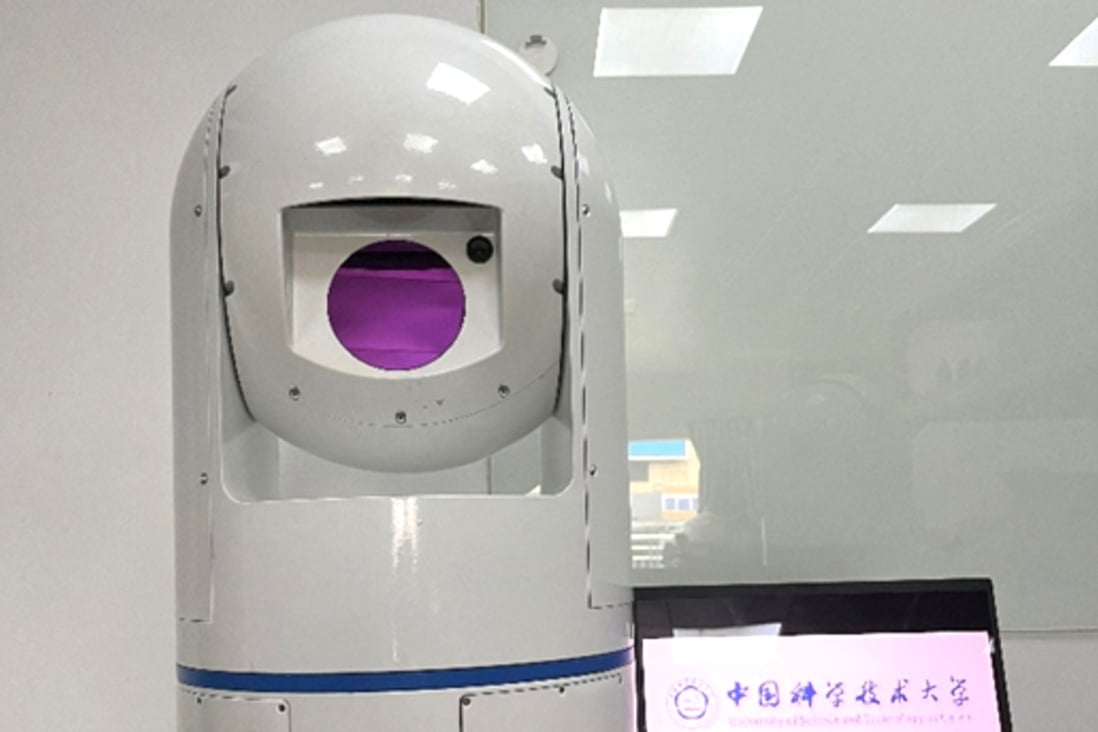China’s scientific community is engaged in developing state-of-the-art equipment for dual-use, with the latest being a unique laser radar that detects the variation in the wind speed.
In a new development, Chinese researchers have claimed to have developed the most sophisticated wind detection laser in the world, which might be used to monitor air pollution, forecast the weather, and accelerate high-speed trains, Hong Kong-based South China Morning Post reported.
The suitcase-sized instrument uses Lidar techniques to detect subtle variations in the wind in remarkable detail. A laser is used to measure the relative movement of air in the atmosphere in a process known as Lidar or Light, Detection, and Ranging.
“Atmospheric wind field detection with meter-level resolution will play a significant role in aerospace safety, high-value target protection, and numerical weather forecasting,” said a statement from the University of Science and Technology of China (USTC) in the eastern province of Anhui.

The researchers declared that mass production of their Light Detection and Ranging (Lidar) device was now possible. Once commercialized, it might be applied to military and civilian applications such as aviation, air quality monitoring, weather forecasting, and other fields.
It is pertinent to note that Lidar-based wind detection has a wide-ranging military application.
In 2019, it was revealed that China had started building the world’s most powerful laser radar designed to study the physics of the Earth’s high atmosphere. At the time, it was claimed that it would be used to research atmospheric particles that act as the planet’s first line of defense against dangerous extraterrestrial objects like solar winds and cosmic rays.
Later, in April 2022, China launched the world’s first satellite with laser radar to study carbon dioxide. The unique launch aimed to improve global carbon and air pollution monitoring capacity and realize the leapfrog development of China’s atmospheric remote sensing technology.
However, the current development of a laser radar for wind detection is significant in its own right. US-based defense contractor Raytheon developed the first-ever laser radar for wind detection in 1970.
Professor Dou Xiankang from USTC was in charge of the study. According to the announcement by Dou and his team, the new laser radar’s sensitivity has outperformed the existing technology by two orders of magnitude in terms of sensitivity.
Braving And Detecting Winds
Light Detection and Ranging is a remote sensing method that uses light as a pulsed laser to measure ranges (variable distances) to the Earth. While China has made significant strides in Lidar technology, the competition is stiff.
However, China’s new laser radar development might make China’s high-speed trains faster and safer, according to the researchers, who claimed that the device had let them spot peculiar high-speed train turbulence that had never been seen before.
The radar development became even more significant a few weeks after a bullet train in China suffered a crash.

The Chinese researchers have tried to improve radar’s spatial and temporal resolution since they started exploring Lidar technology. The most sophisticated method is pulse coherent Doppler wind Lidar (PCDWL).
However, even with this, achieving resolutions of less than 10 meters (32.8 feet) and one second is challenging.
Doppler wind Lidar (DWL), extensively used in engineering and scientific studies, uses the Optical Doppler effect to determine atmospheric wind speed with high spatial-temporal resolution and extended detection range. The Doppler Lidar works by transmitting short pulses of infrared laser light into the atmosphere.
Despite entering the Lidar race late, China has recently made significant strides in Lidar research. In 2019 and 2021, the work of Dou’s team enabled the reduction of spatial resolution to less than 10 meters by introducing a technique known as pulse coding.
The researchers’ latest paper, published on June 22 in the worldwide peer-reviewed journal Optic Letters, stated that their prototype PCDWL device had reached spatial and temporal resolutions of 3 meters and 0.1 seconds, respectively. To assess the effectiveness of the system, the team ran several trials.

How Did The Chinese Scientists Do It?
They began by monitoring the system using an anemometer, a tool for measuring wind speed, which was highly accurate, according to the researchers. The team’s hyperfine PCDWL technology successfully measured wind speed to within 0.5 meters per second during a test on the USTC campus.
After that, Dou’s team conducted a second experiment at a high-speed train station in Suzhou, Anhui province. The PCDWL equipment continuously captured photographs of the high-speed wake created by bullet trains passing 350 kilometers/hour for more than 100 hours (217.5 miles per hour).
The observation, which attained previously unheard-of three meters and 0.1-second resolutions, showed spinning vortexes with recurrent patterns called “Von Karman vortex shedding.”
According to computer modeling, these vortexes can be formed near the tail of a high-speed train, but no one has ever observed one in action. According to the researchers, the discovery may improve high-speed maglev trains’ stability, effectiveness, and safety.
A 600 kilometers/hour maglev train, which is almost twice as fast as the existing limit, is being developed in China. It was revealed as part of a five-year plan for innovation under railway science and technology by the National Railway Administration (NRA).
On July 20, the world's first 600 km/h high-speed maglev transportation system was successfully launched in Qingdao, China. With the designed top speed of 600 km/h, this domestically developed system makes the maglev train currently the fastest ground vehicle available globally. pic.twitter.com/aUcoRiCrim
— FANG Qiu (@AmbFangQiu) July 20, 2021
According to the researchers, laser radar performance can be impacted by rain and fog, but the high-speed train experiment demonstrated how effectively the system adjusts to environmental factors. Additionally, the laser’s operating wavelength is safe for human eyes, and the device weighs roughly 40 kilograms (88 lbs), making it appropriate for use in the field.
Dou’s work is outstanding, according to a Nanjing-based researcher who studies Lidar technology, but there is stiff competition in the market. The researcher, who asked to remain anonymous, said that other Chinese teams would soon surpass it with much greater accuracy.
While the Chinese team has focused on the railway, the laser radar could have critical applications in aviation as well as informed by the team. The competition might be break-neck inside China. But one thing is for sure – China has made incredible progress with Lidar despite being a newcomer in the field.
- Contact the author at sakshi.tiwari9555@gmail.com
- Follow EurAsian Times on Google News




